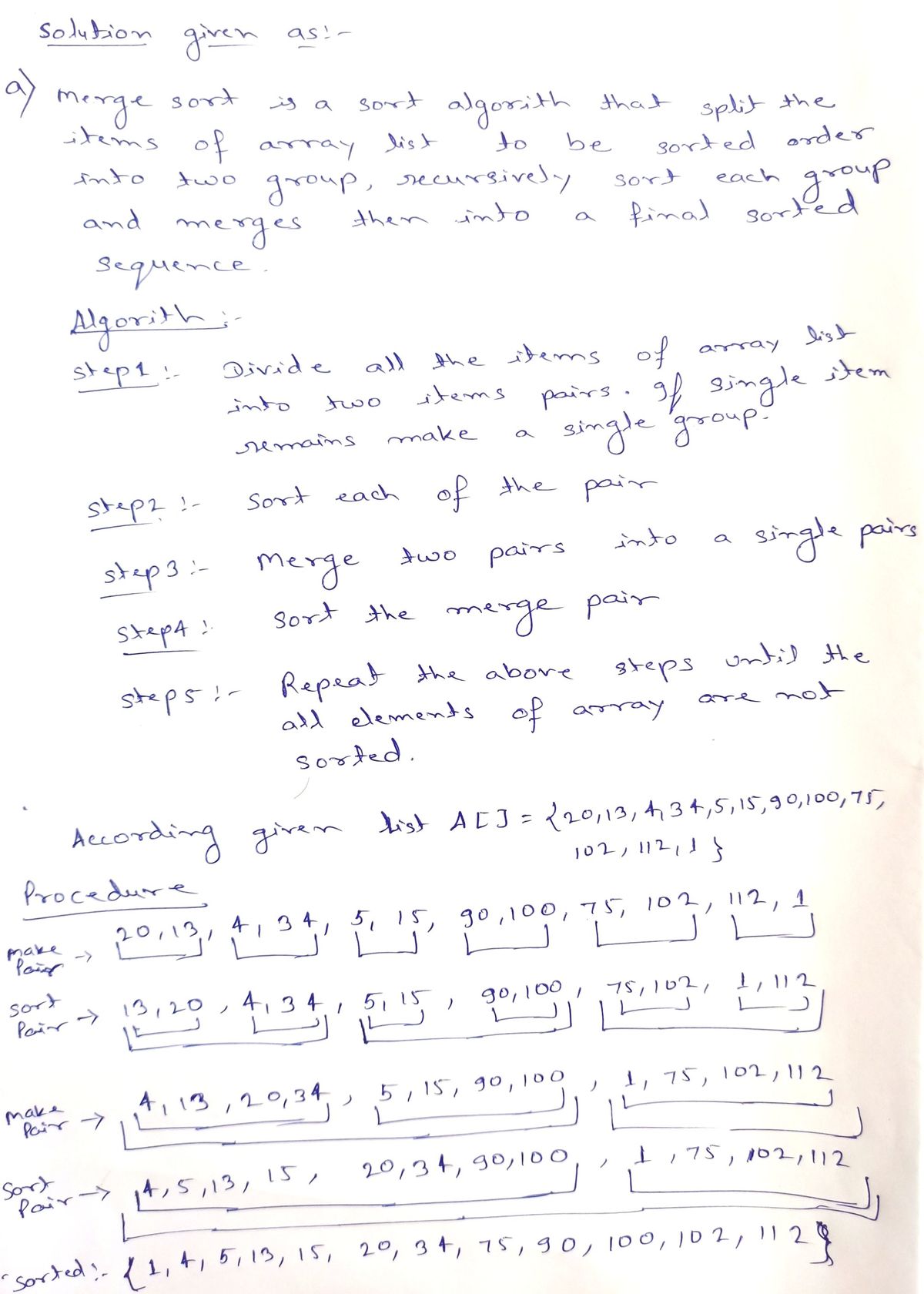4- Sort the list A[]={ 20, 13,4, 34, 5, 15, 90, 100, 75, 102, 112, 1} a) Using Merge Sort and show the order that the Merge procedure is performed. b) Explain the average case of Merge Sort. Give a detail explanation of how we can estimate the mean in relationship with the worst and best-case scenarios (hint: use the answer for question 3 as a lower-bound for the average).
4- Sort the list A[]={ 20, 13,4, 34, 5, 15, 90, 100, 75, 102, 112, 1} a) Using Merge Sort and show the order that the Merge procedure is performed. b) Explain the average case of Merge Sort. Give a detail explanation of how we can estimate the mean in relationship with the worst and best-case scenarios (hint: use the answer for question 3 as a lower-bound for the average).
Database System Concepts
7th Edition
ISBN:9780078022159
Author:Abraham Silberschatz Professor, Henry F. Korth, S. Sudarshan
Publisher:Abraham Silberschatz Professor, Henry F. Korth, S. Sudarshan
Chapter1: Introduction
Section: Chapter Questions
Problem 1PE
Related questions
Question
![**Problem 4: Merge Sort Example and Analysis**
---
**a) Sorting the List Using Merge Sort**
List: \( A = \{ 20, 13, 4, 34, 5, 15, 90, 100, 75, 102, 112, 1 \} \)
**Using Merge Sort:**
1. **Divide Step:**
- Split the list into two halves until each sublist contains a single element:
- First Split: \(\{20, 13, 4, 34, 5, 15\}\) and \(\{90, 100, 75, 102, 112, 1\}\)
- Continue splitting each half recursively until individual elements are obtained.
2. **Conquer (Merge) Step:**
- Begin merging the single elements:
- Merge \(\{20\}\) and \(\{13\}\) into \(\{13, 20\}\)
- Continue merging adjacent sublists in sorted order.
- Follow this method recursively for each level up the recursion tree until the sorted list is obtained.
**Final Merged List:**
\[
\{1, 4, 5, 13, 15, 20, 34, 75, 90, 100, 102, 112\}
\]
---
**b) Explanation of the Average Case of Merge Sort**
Merge Sort has a time complexity of \(O(n \log n)\) for all cases (best, average, and worst) because the list is always split into two halves, and the merging process for items takes linear time in relation to the number of elements being merged.
- **Average Case Analysis:**
- Merge Sort divides the problem into smaller subproblems, sorts them, and then merges back the sorted sublists.
- Each level of recursion involves partitioning and merging the entire dataset.
- The known answer for question 3 serves as a lower-bound estimator, affirming that due to its recursive nature and optimal divide-and-conquer approach, Merge Sort always adheres to a time complexity of \(O(n \log n)\) regardless of the initial distribution of data elements.
This ensures efficiency and stability, making Merge Sort a reliable choice for sorting large datasets, as it consistently performs well across different scenarios.](/v2/_next/image?url=https%3A%2F%2Fcontent.bartleby.com%2Fqna-images%2Fquestion%2Ff6caac49-b571-4d61-a050-647f9235352a%2Ff200f1e8-4fe0-4b13-a443-eb14eb854a00%2Fbb6fgts_processed.png&w=3840&q=75)
Transcribed Image Text:**Problem 4: Merge Sort Example and Analysis**
---
**a) Sorting the List Using Merge Sort**
List: \( A = \{ 20, 13, 4, 34, 5, 15, 90, 100, 75, 102, 112, 1 \} \)
**Using Merge Sort:**
1. **Divide Step:**
- Split the list into two halves until each sublist contains a single element:
- First Split: \(\{20, 13, 4, 34, 5, 15\}\) and \(\{90, 100, 75, 102, 112, 1\}\)
- Continue splitting each half recursively until individual elements are obtained.
2. **Conquer (Merge) Step:**
- Begin merging the single elements:
- Merge \(\{20\}\) and \(\{13\}\) into \(\{13, 20\}\)
- Continue merging adjacent sublists in sorted order.
- Follow this method recursively for each level up the recursion tree until the sorted list is obtained.
**Final Merged List:**
\[
\{1, 4, 5, 13, 15, 20, 34, 75, 90, 100, 102, 112\}
\]
---
**b) Explanation of the Average Case of Merge Sort**
Merge Sort has a time complexity of \(O(n \log n)\) for all cases (best, average, and worst) because the list is always split into two halves, and the merging process for items takes linear time in relation to the number of elements being merged.
- **Average Case Analysis:**
- Merge Sort divides the problem into smaller subproblems, sorts them, and then merges back the sorted sublists.
- Each level of recursion involves partitioning and merging the entire dataset.
- The known answer for question 3 serves as a lower-bound estimator, affirming that due to its recursive nature and optimal divide-and-conquer approach, Merge Sort always adheres to a time complexity of \(O(n \log n)\) regardless of the initial distribution of data elements.
This ensures efficiency and stability, making Merge Sort a reliable choice for sorting large datasets, as it consistently performs well across different scenarios.
Expert Solution
Step 1

Step by step
Solved in 2 steps with 1 images

Knowledge Booster
Learn more about
Need a deep-dive on the concept behind this application? Look no further. Learn more about this topic, computer-science and related others by exploring similar questions and additional content below.Recommended textbooks for you

Database System Concepts
Computer Science
ISBN:
9780078022159
Author:
Abraham Silberschatz Professor, Henry F. Korth, S. Sudarshan
Publisher:
McGraw-Hill Education

Starting Out with Python (4th Edition)
Computer Science
ISBN:
9780134444321
Author:
Tony Gaddis
Publisher:
PEARSON

Digital Fundamentals (11th Edition)
Computer Science
ISBN:
9780132737968
Author:
Thomas L. Floyd
Publisher:
PEARSON

Database System Concepts
Computer Science
ISBN:
9780078022159
Author:
Abraham Silberschatz Professor, Henry F. Korth, S. Sudarshan
Publisher:
McGraw-Hill Education

Starting Out with Python (4th Edition)
Computer Science
ISBN:
9780134444321
Author:
Tony Gaddis
Publisher:
PEARSON

Digital Fundamentals (11th Edition)
Computer Science
ISBN:
9780132737968
Author:
Thomas L. Floyd
Publisher:
PEARSON

C How to Program (8th Edition)
Computer Science
ISBN:
9780133976892
Author:
Paul J. Deitel, Harvey Deitel
Publisher:
PEARSON

Database Systems: Design, Implementation, & Manag…
Computer Science
ISBN:
9781337627900
Author:
Carlos Coronel, Steven Morris
Publisher:
Cengage Learning

Programmable Logic Controllers
Computer Science
ISBN:
9780073373843
Author:
Frank D. Petruzella
Publisher:
McGraw-Hill Education